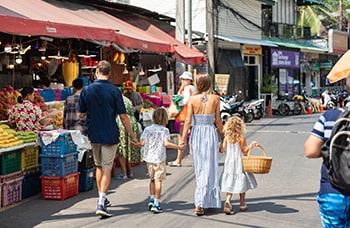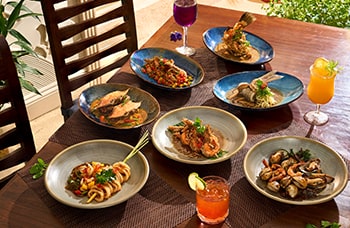NEWS RELEASE
Dining Guides
Explore the best of Phuket with our expert holiday guides and travel tips. From the top seafood restaurants in Karon Beach to must-see attractions, we provide helpful insights to make your Phuket vacation unforgettable
-

How to Make Tom Yum Kung Like a Thai Chef
Learn how to make tom yum kung from expert Thai chefs when you attend a cooking class at Ocean Rhyme.
LEARN MORE
-

Try These Popular Thai Sweets at Ocean Rhyme
Experience popular Thai sweets at Ocean Rhyme like traditional mango sticky rice, coconut ice cream, and many more.
LEARN MORE
-

Explore Fresh Seafood Markets in Phuket and Dine Local
Explore the top seafood markets in Phuket, then enjoy fresh catches and refined beachside dining at Ocean Rhyme.
LEARN MORE
-

Best Time To Visit Phuket For The Ultimate Seafood Experience
Planning your trip? Learn about the seafood season in Phuket and how to enjoy premium catches and perfect weather for the ultimate dining experience.
LEARN MORE
-

Best Fresh Markets in Phuket and Cooking Class Experience
Visit the best fresh markets in Phuket and try your hand at cooking traditional Thai dishes at Ocean Rhyme’s cooking school.
LEARN MORE
-

Best Local Food To Try In Phuket: 6 Amazing Dishes
Dive into authentic Phuket local dishes shaped by Chinese, Malay & Thai influences. Discover 6 must-try flavors at Ocean Rhyme with ocean views.
LEARN MORE
-

4 Thai Dishes To Avoid if You’re Dieting
Given that the vast majority of Thai people seem to have very slim and slight figures, the assumption would naturally be that Thai food is extremely healthy. Here are some of the worst offenders - the dishes to avoid ordering in a Phuket Thai restaurant if you’re trying to lose weight.
LEARN MORE
-

สมุนไพรผักพื้นบ้านและผลไม้ยอดนิยม ที่มักพบในอาหารไทย!
พืชสมุนไพรต่างๆของไทยนั้น ตั้งแต่โบราณก็เป็นที่ทราบกันดีอยู่แล้วว่า มีคุณค่าทางยามากมาย ซึ่งในอาหารไทยที่เรารับประทานกันในชีวิตประจำวัน ล้วนก็ประกอบไปด้วยสมุนไพรนานาชนิด เป็นวัตถุดิบผสมอยู่ด้วยทั้งสิ้น
LEARN MORE
-

“ข้าวซอย” อาหารไทยท้องถิ่นของภาคเหนือ
ข้าวซอยเป็นอาหารพื้นบ้านของทางภาคเหนือ เชื่อกันว่าหากใครไปเที่ยวเชียงใหม่แล้วไม่ได้ขึ้นดอยสุเทพ หรือไม่ได้กินข้าวซอยก็เหมือนไปไม่ถึงเชียงใหม่ วันนี้หากใครอยากกินข้าวซอยไม่ต้องไปถึงเชียงใหม่แล้ว เพราะเราได้นำสูตรและวิธีการทำข้าวซอยมาให้ทุกคนได้ทดลองทำกัน
LEARN MORE
-

สุดยอดเมนู "กุ้งแม่น้ำ" ที่หลายๆคนชื่นชอบ
กุ้งแม่น้ำ ถือได้ว่าเป็นเมนูที่ได้รับความนิยมเป็นอย่างมากสำหรับคนไทยและคนต่างชาติ ซึ่งสามารถนำมาประกอบอาหารได้หลากหลายเมนู วันนี้เลยนำสูตรวิธีการทำง่ายๆ สามารถทำทานเองได้ที่บ้าน มาฝากผู้อ่านกัน
LEARN MORE
-

มารยาทบนโต๊ะอาหารที่ทุกคนควรรู้
มารยาทในการรับประทานอาหารเป็นสิ่งสำคัญ ไม่ว่าชาติใดก็มักจะมีเอกลักษณ์และขนบธรรมเนียมในการปฏิบัติเฉพาะตัว รวมทั้งประเทศไทยของเราด้วย ดังนั้นเราจึงควรฝึกมารยาทในการรับประทานอาหารให้ถูกต้องและเป็นที่ยอมรับของสังคม
LEARN MORE
-
 4 Quick and Easy Thai Food Dishes
4 Quick and Easy Thai Food Dishes
While it is undoubtedly best to savour Thai dining in a Phuket restaurant, you don’t necessarily need to travel across the globe to enjoy the wonderful flavours you can enjoy here. That being the case, we’ve picked out a selection of tasty Thai food dishes you can prepare quickly and without too much effort.
LEARN MORE
-
 The Perfect Tom Yum Gung
The Perfect Tom Yum Gung
The spicy tom yum soup is often ranked among the favourite dishes ordered by visitors to Phuket Thai restaurants. While it may or may not have originated in Southern Thailand, it’s certainly popular and widely available here. The complex flavour is at once tangy and tart, a little sweet and a bit smooth - it’s a fantastic example of the remarkable flavours Thai food is famous for.
LEARN MORE
-
 อาหารไทย 4 ภาค ที่ใครมาก็ต้องลอง!!!
อาหารไทย 4 ภาค ที่ใครมาก็ต้องลอง!!!
เนื่องจากประเทศไทยมีลักษณะภูมิประเทศเป็นแนวยาว อาหารการกินก็จะแตกต่างกันออกตามวัตถุดิบที่หาได้จากแหล่งอาหารในพื้นที่นั้นๆด้วย ซึ่งอาหารพื้นบ้านเหล่านี้สามารถแบ่งออกเป็นภูมิภาคหลักๆได้ 4 ภาค ได้แก่ เหนือ กลาง ใต้ และอีสาน
LEARN MORE
-
 ประวัติและความสำคัญของ “วันมาฆบูชา”
ประวัติและความสำคัญของ “วันมาฆบูชา”
วันมาฆบูชา ตรงกับวันขึ้น 15 ค่ำ เดือน 3 โดยวันมาฆบูชา 2563 ตรงกับวันเสาร์ที่ 8 กุมภาพันธ์ ซึ่งเป็นวันที่พระพุทธเจ้าทรงแสดง “โอวาทปาติโมกข์” อันเป็นหลักคำสอนสำคัญของพระพุทธศาสนา
LEARN MORE
-
 เมนูอาหารไทยแนะนำสูตรดั้งเดิม ต้นตำรับแบบชาววังที่ใครมาก็ต้องลอง พร้อมวิธีการทำ
เมนูอาหารไทยแนะนำสูตรดั้งเดิม ต้นตำรับแบบชาววังที่ใครมาก็ต้องลอง พร้อมวิธีการทำ
ปัจจุบันอาหารไทยบางเมนูแทบจะหาทานไม่ได้เลยตามร้านอาหารทั่วไป วันนี้จึงได้รวบรวมเมนูอาหารไทยสูตรดั้งเดิมพร้อมวิธีการทำมาแนะนำกัน มีเมนูอะไรบ้างไปดูกันเลย!
LEARN MORE
-
 รวม 5 อันดับ ผับดัง ภูเก็ต - 5 Famous Phuket Nightclub
รวม 5 อันดับ ผับดัง ภูเก็ต - 5 Famous Phuket Nightclub
ก่อนอื่นต้องบอกเลยว่าผู้เขียนอยู่ภูเก็ตมานานและมีเพื่อนเยอะ แล้วโดนเพื่อนลากไปเที่ยวด้วยตลอด ก็เลยอยากจะมาแชร์สถานที่ท่องเทียวกลางคืน หรือ ที่ฝรั่งเรียกกันว่า Phuket Night Club มาแนะนำหนุ่มสาวโสดที่อยากโกอินเตอร์ เรามาเริ่มอันดับแรกกันเลย
LEARN MORE
-
 การประกอบพิธีกรรมช่วงเทศกาลถือศีลกินผักจังหวัดภูเก็ต
การประกอบพิธีกรรมช่วงเทศกาลถือศีลกินผักจังหวัดภูเก็ต
เทศกาลถือศีลกินผักในภูเก็ต ถือเป็นอีกหนึ่งเทศกาลที่ได้รับความสนใจจากนัดท่องเที่ยวและคนในท้องถิ่นเป็นอย่างมาก แต่จะมีพิธีกรรมอะไรบ้างตามมาเลย
LEARN MORE
-
 กิจกรรมปลูกป่าชายเลน (Young Blood Training ไกด์รุ่นใหม่หัวใจอนุรักษ์)
กิจกรรมปลูกป่าชายเลน (Young Blood Training ไกด์รุ่นใหม่หัวใจอนุรักษ์)
ภูเก็ตเป็นจังหวัดท่องเที่ยวที่มีทรัพยากรธรรมชาติมากมาย ไม่ว่าจะเป็นภูเขา และทะเล นอกจากมีธรรมชาติที่สวยงามแล้วยังมีป่าชายเลนอีกด้วย ปัจจุบันป่าชายเลนเริ่มเสื่อมโทรมและลดน้อยลงไปมาก - กิจกรรมปลูกป่าชายเลน
LEARN MORE
-
 ทำไมต้องไปภูเก็ต? - Thing to Do in Phuket
ทำไมต้องไปภูเก็ต? - Thing to Do in Phuket
จังหวัดท่องเที่ยวอันดับต้นๆที่เราจะนึกถึงแน่นอนคงหนีไม่พ้นจังหวัดภูเก็ต แต่อะไรคือเสน่ห์ที่ทำให้คนไทย หรือ ชาวต่างชาติให้ความนิยมในการเลือกมาท่องเที่ยวที่นี้ ไปดูกันเลย
LEARN MORE

